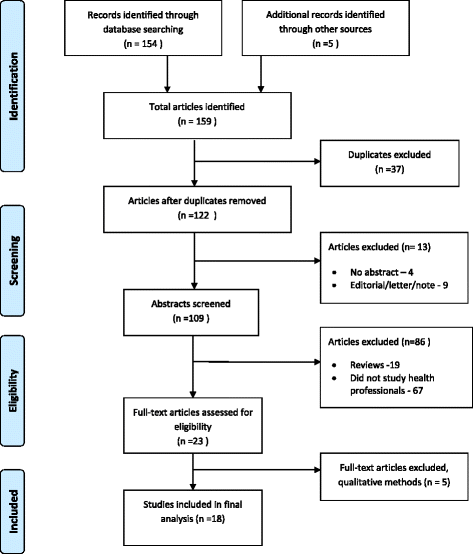Female genital mutilation and cutting: a systematic literature review of health professionals' knowledge, attitudes and clinical practice
- PMID: 26652275
- PMCID: PMC4676087
- DOI: 10.1186/s12914-015-0070-y
Female genital mutilation and cutting: a systematic literature review of health professionals' knowledge, attitudes and clinical practice
Abstract
Background: The World Health Organisation (WHO) estimates that 100-140 million girls and women have undergone female genital mutilation or cutting (FGM/C). FGM/C is an ancient cultural practice prevalent in 26 countries in Africa, the Middle East and Asia. With increased immigration, health professionals in high income countries including UK, Europe, North America and Australia care for women and girls with FGM/C. FGM/C is relevant to paediatric practice as it is usually performed in children, however, health professionals' knowledge, clinical practice, and attitudes to FGM/C have not been systematically described. We aimed to conduct a systematic review of the literature to address this gap.
Methods: The review was conducted according to guidelines of the Preferred Reporting Items for Systematic Reviews and Meta-Analyses (PRISMA) statement and registered with the PROSPERO International Prospective Register of Systematic Reviews (CRD42015015540, http://www.crd.york.ac.uk/PROSPERO/). Articles published in English 2000-2014 which used quantitative methods were reviewed.
Results: Of 159 unique articles, 18 met inclusion criteria. The methodological quality was poor - six studies met seven of the eight quality criteria. Study participants included mainly obstetricians, gynaecologists and midwives (15 studies). We found no papers that studied paediatricians specifically, but two papers reported on subgroups of paediatricians within a mixed sample of health professionals. The 18 articles covered 13 different countries: eight from Africa and 10 from high income countries. Most health professionals were aware of the practice of FGM/C, but few correctly identified the four FGM/C categories defined by WHO. Knowledge about FGM/C legislation varied: 25% of professionals in a Sudanese study, 46 % of Belgian labour ward staff and 94 % of health professionals from the UK knew that FGM/C was illegal in their country. Health professionals from high income countries had cared for women or girls with FGM/C. The need to report children with FGM/C, or at risk of FGM/C, to child protection authorities was mentioned by only two studies.
Conclusion: Further research is needed to determine health professionals' attitudes, knowledge and practice to support the development of educational materials and policy to raise awareness and to prevent this harmful practice.
Figures
Comment in
-
Health professionals worldwide lack knowledge on female genital mutilation.BMJ. 2015 Dec 9;351:h6693. doi: 10.1136/bmj.h6693. BMJ. 2015. PMID: 26657093 No abstract available.
References
-
- WHO. Eliminating female genital mutilation: the imperative 2008. Available from: http://whqlibdoc.who.int/publications/2008/9789241596442_eng.pdf (Accessed May 2015)
-
- UNCIEF. Female Genital Mutilation/Cutting: A statistical overview and exploration of the dynamics of change.: UNICEF; 2013. ISBN 978-92-806-4703-7]. Available from: http://www.childinfo.org/files/FGCM_Lo_res.pdf. (Accessed May 2015)
-
- WHO. Global Strategy to stop health-care providers from performing female genital mutilation UNAIDS, UNDP, UNFPA, UNICEF, UNHCR, UNIFEM, WHO, FIGO, ICN, IOM, WCPT, WMA, MWIA. 2010; WHO/RHR/10.9. Available from: http://www.who.int/reproductivehealth/publications/fgm/rhr_10_9/en/ (Accessed May 2015)
-
- Matthews B. Female genital mutilation: Australian law, policy and practical challenges for doctors. Med J Aust. 2011;194(3):139–41. - PubMed
-
- Multi-Agency Practice Guidelines: Female Genital Mutilation. HM Government, 2014. Available from: https://www.gov.uk/government/uploads/system/uploads/attachment_data/fil... (Accessed February 2015)
Publication types
MeSH terms
LinkOut - more resources
Full Text Sources
Other Literature Sources
Miscellaneous


